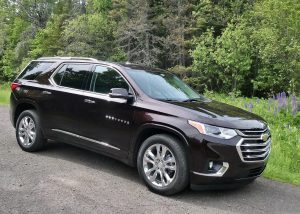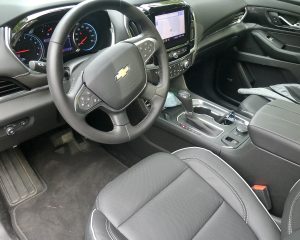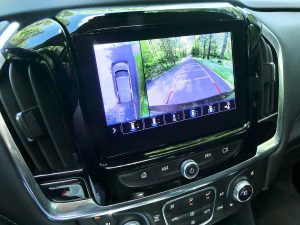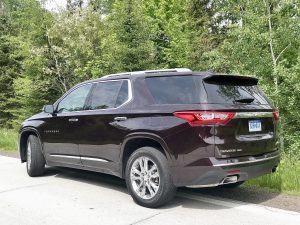Traverse grows up to challenge Tahoe segment
By John Gilbert
In the old days, Chevrolet took care of all the size requirements for SUVs by offering small (Blazer), medium (Tahoe) and large (Suburban). Of course, those intentions expanded to the 2020 model year, when Chevrolet stretches from the largest Suburban, to the Tahoe, then the midsize Traverse, down to the reimagined Blazer, the compact Equinox, the more-compact Trax, and the also-compact TrailBlazer.
There was a recent time when fuel economy restrictions caused a realistic elimination of the largest vehicles and a splurge of the compacts. But my memory was challenged recently, after I test-drove and reported on the new Chevrolet Equinox, which surprised me because it performed well and handled impressively in its latest form.
Most recently, I got a Traverse to test for a week, and when I first laid eyes on it, I was impressed by the shapely form that made it look modern and sporty, with a dash of luxury. When I climbed into the driver’s seat, I was impressed with the amount of room, and when I hit the ignition button and stepped on the gas, it took off with a bit of a jolt, and it showed tendencies for power whenever I touched the gas.
Always looking for the reasons a company builds a certain vehicle, I thought it was curious that the new midsize Traverse seemed to have grown into something larger than midsize. In fact, I thought the Traverse might have been a flashback for Chevy, to the days when it built vehicles that were always a little bigger than last year’s models, gradually luring us to buying bigger vehicles that were, yes, less fuel-efficient, while hauling larger groups of people.
Because of the difficulty I had estimating the dimensions whenever I tried to park the Traverse, and the way it seemed almost cumbersome whenever I tried to take a corner with a dose of performance, the Traverse’s size bothered me. The old rule still works, that if you need more room you have to sometimes build the vehicle bigger, but the Traverse seemed to have grown large enough to intrude on the Tahoe’s turf.
The Equinox, which I declared “big enough” for almost any family’s duties, seemed like a compact sporty-car by comparison. True, the Traverse has a larger 3.6-liter V6 with 308 horsepower and 270 foot-pounds of torque compared to the Equinox, and it will haul seven, if you fill all three rows. But my curiosity had to do with comparisons to the larger Tahoe — which itself has grown in its all-new form to rival the gigantic Suburban.
After a little detective work I found that the Traverse is 204.3 inches long, with a wheelbase of 120.9 inches, and 98.2 cubic feet of cargo space if you fold the second and third rows down, which shrinks to 23.0 cubic feet if all the seats are in sitting position. The new Tahoe is 210.7 inches long, with a 120.9 wheelbase identical to the Traverse, but that is for a 2021 Tahoe. If we drop back to the current 2020 Tahoe, the overall length is 204 and wheelbase 116 inches.
So my hunch was correct. The Traverse is slightly longer than the current Tahoe, with a longer wheelbase. But Chevrolet, in order to make room for it, slyly increased the Tahoe by 6 inches in length for the 2021 model, boasting that it’s bigger than ever, and staying larger than the fattened-but-sleeker Traverse, which is also “bigger and better.”
In normal combined driving in and around Duluth, Minnesota, with its hills, the best we got in fuel economy was 23.7 miles per gallon, which is OK for the size of the Traverse, but leaves it at a deficit against some of the top Asian and European models, to say nothing of Ford’s EcoBoosted 4-cylinders.
But if it seems as though General Motors might have slipped a cog in its advancement toward better economy, the Traverse has a lot of impressive features that can help justify the “High Country” test vehicle to rise from a $40,000 base price to a sticker of $54,395.
It has all-wheel drive, of course, and a 9-speed automatic that handled its power, even if it did seem to launch with a drag-racing jolt. The 20-inch wheels are polished aluminum, and the safety features are plentiful. Rear cross-traffic alert, lane change alert, blind side alert, forward collision alert, are augmented by lane-keep assist, enhanced emergency braking, front pedestrian braking, and forward collision alert.
A large, dual-pane sunroof and LED lights all around, plus a hands-free lift gate and remote starting are nice features. The seats are leather trimmed, and the front bucket are heated and cooled, and the second-row seats are also heated. The premium audio system and navigation and a 10-speaker Bose coordinates through an 8-inch diagonal touchscreen.
The second row of seats was comfortable buckets, and the sliding second row moved forward to allow easier access to the third row. Granted, the third row is a split bench best-suited for tiny people, like children, and will probably spend almost all its life folded flat into the floor. Still, if you have only occasional need for a third row to increase occupancy from five to seven, you could appreciate it. Same as the 5-star crash test stature.
Actually, there are no options for the $54,395 price tag. The base, front-wheel-drive Traverse starts at $40,000, but as you move up in features and conveniences, you get up to the top model in the fleet, which is the High Country, and that is $53,200. Final assembly is in Lansing, Mich., with the engine built in Mexico.
The Traverse has an attractive look, and might well appeal to everybody up to and including a Tahoe buyer, and my only cautioning idea is to also check out the more compact but surprisingly roomy Equinox. Especially if you take comparison test-drives around a cloverleaf.






 John Gilbert is a lifetime Minnesotan and career journalist, specializing in cars and sports during and since spending 30 years at the Minneapolis Tribune, now the Star Tribune. More recently, he has continued translating the high-tech world of autos and sharing his passionate insights as a freelance writer/photographer/broadcaster. A member of the prestigious North American Car and Truck of the Year jury since 1993. John can be heard Monday-Friday from 9-11am on 610 KDAL(www.kdal610.com) on the "John Gilbert Show," and writes a column in the Duluth Reader.
John Gilbert is a lifetime Minnesotan and career journalist, specializing in cars and sports during and since spending 30 years at the Minneapolis Tribune, now the Star Tribune. More recently, he has continued translating the high-tech world of autos and sharing his passionate insights as a freelance writer/photographer/broadcaster. A member of the prestigious North American Car and Truck of the Year jury since 1993. John can be heard Monday-Friday from 9-11am on 610 KDAL(www.kdal610.com) on the "John Gilbert Show," and writes a column in the Duluth Reader.